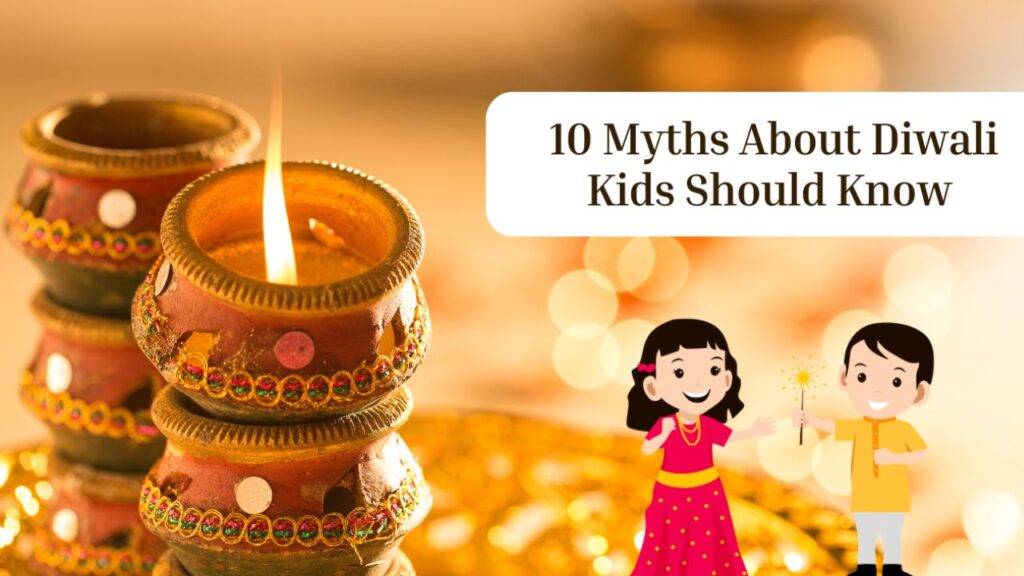Diwali, also known as the Festival of Lights, is celebrated with great excitement, colorful lights, and lots of sweets. Kids and adults alike look forward to Diwali for all the festive fun, but many things we hear about Diwali are actually myths. These myths, which have been passed down for generations, sometimes mix up the real facts with fictional ideas.
Here’s a breakdown of some common myths about Diwali by Dr. Kishore’s Ratnam Schools in Nellore, Kavali, Tirupati & Srikalahasti that kids (and even grown-ups!) should know.
1. Myth: Diwali Is Only Celebrated for Lord Rama’s Return
Fact: While the return of Lord Rama to Ayodhya is one reason people celebrate Diwali, there are other stories and traditions associated with it too. For instance, in some parts of India, people celebrate Diwali to honor Goddess Lakshmi, the goddess of wealth and prosperity. In West Bengal, it’s celebrated as “Kali Puja” to honor Goddess Kali. Different regions have their own legends tied to Diwali, making it a festival with many meanings.
2. Myth: Diwali Is the Same Everywhere
Fact: Diwali celebrations vary greatly across India and the world. While lighting diyas (lamps), bursting firecrackers, and worshiping are common, different states have unique ways of celebrating. In Maharashtra, Diwali marks the victory of Lord Krishna over the demon Narakasura, while in Tamil Nadu, people focus on Naraka Chaturdashi as an essential part of Diwali. So, Diwali isn’t celebrated in exactly the same way everywhere—it’s a mix of local traditions and customs!
3. Myth: Diwali Is Only for Hindus
Fact: Diwali is mainly celebrated by Hindus, but it’s also an important festival for Sikhs, Jains, and some Buddhists. Sikhs celebrate Diwali as “Bandi Chhor Divas” to commemorate the release of Guru Hargobind Ji from imprisonment. For Jains, it marks the day when Lord Mahavira, a spiritual leader, attained Nirvana (liberation). This diversity shows that Diwali is a festival of joy for various communities, not just Hindus.
4. Myth: Firecrackers Ward Off Evil Spirits
Fact: Firecrackers have become a big part of Diwali celebrations, but they don’t actually drive away evil spirits. The original reason for lighting lamps and diyas during Diwali was to signify the victory of light over darkness and good over evil. Over time, bursting crackers was added as a form of celebration, but it’s not necessary. Today, people are encouraged to celebrate in eco-friendly ways, reducing noise and air pollution.
5. Myth: You Must Buy New Things for Diwali
Fact: While it’s common to see people shopping during Diwali, especially for new clothes, this isn’t a rule. The purpose of Diwali shopping is actually to bring joy and welcome prosperity, not to force people into spending money. It’s more important to clean and decorate your home to welcome positive energy. Buying new things is just a tradition for those who can afford it, but it’s not necessary to enjoy the festival.
6. Myth: Diwali Is Only Celebrated for a Day
Fact: Diwali celebrations typically last for five days, each day having its own importance. Here’s a quick look at the five-day celebrations:
- Day 1: Dhanteras – Celebrated for wealth and health.
- Day 2: Naraka Chaturdashi – Marks the victory over Narakasura.
- Day 3: Lakshmi Puja – The main day, honoring Goddess Lakshmi.
- Day 4: Govardhan Puja – Celebrates Lord Krishna.
- Day 5: Bhai Dooj – Honors the bond between brothers and sisters.
So, Diwali isn’t just a one-day event; it’s a whole festival of rituals and joy spread across five days!
7. Myth: Diwali Is About Gaining Wealth and Material Goods
Fact: Diwali is sometimes associated with buying things and gaining wealth, but the deeper meaning is more about inner prosperity. The light of Diwali symbolizes wisdom, kindness, and the goodness inside everyone. While people worship Goddess Lakshmi, the goddess of wealth, the true celebration of Diwali is about gaining happiness, health, and peace.
8. Myth: Eating Sweets and Snacks Means Gaining Weight
Fact: Yes, Diwali is filled with delicious sweets and snacks, but enjoying them in moderation won’t automatically lead to weight gain. In fact, many traditional Diwali sweets are made with wholesome ingredients like ghee, nuts, and jaggery, which have health benefits when eaten wisely. The key is to savor and enjoy the festive treats without overindulging. Besides, Diwali is a time to enjoy special foods with loved ones, so don’t worry too much!
9. Myth: The Brighter the Lights, the Better the Diwali
Fact: Diwali doesn’t need to be flashy to be meaningful. While many people decorate their homes with lights, Diwali’s essence lies in the inner light of kindness, love, and compassion. A single diya has the same significance as a thousand, as both represent the triumph of light over darkness. Decorating with diyas or simple fairy lights is more than enough to make Diwali beautiful.
10. Myth: You Have to Spend Lots of Money on Diwali Gifts
Fact: Gifting is a lovely part of Diwali, but it doesn’t mean you have to spend a lot. Handmade gifts, cards, or simply spending time with loved ones can be just as meaningful. The true spirit of Diwali lies in giving, caring, and making people happy. Expensive gifts aren’t necessary to share the love and warmth of Diwali.
Conclusion
Diwali is a festival of light, love, and joy, but over time, myths have clouded its true meaning. Understanding these myths helps us enjoy the festival in a more meaningful way and appreciate the values of kindness, unity, and happiness. This Diwali, let’s celebrate responsibly and focus on the real essence of the festival—bringing light into the lives of others.


